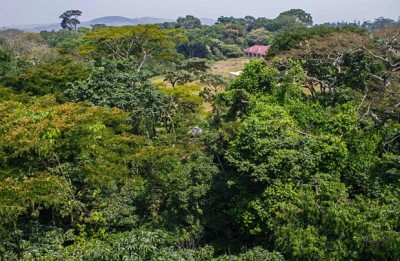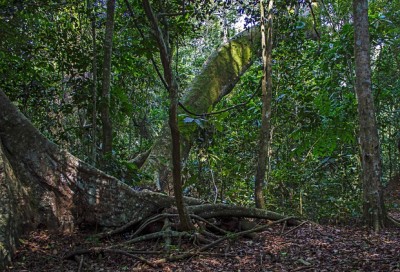
The steel research tower rising over Uganda’s Zika forest is almost 40 metres high, has seven rickety wooden platforms and may be the most perilous place on earth. Slap on the equator, close to Lake Victoria, and set above a malarial swamp full of crocodiles, it has been gingerly climbed by generations of entomologists set on baiting and trapping mosquitoes – and isolating the world’s most dangerous viruses. “It is a global epicentre of pathogens and viruses,” says Louis Mukwaya, head of the entomology department at the Ugandan Virus Research Institute (UVRI) and a world-renowned mosquito researcher. Leopards, snakes and monkeys live in its 24 acres, but breeding in its trees are more than 70 species of mosquito. Together, they harbour dozens of deadly pathogens that could potentially be transferred to man. It is extremely rare to find so many species in one small patch, which makes the forest ideal for research.
Courtesy of the tower comes the ZIKA VIRUS , discovered by Scottish virologist Alexander Haddow in 1947 and named after the forest where it was found – being carried by a mosquito species. Long thought of as a scientific curiosity, it has burst into the medical horror books, suspected of being the cause of microcephaly, a congenital malformation in infants whose mothers were infected during pregnancy.
Zika may be responsible for infant deformities and accompanying heartbreak for parents in Latin America, but in its birthplace, infected people mostly get no more than mild, flu-like symptoms for a few days. Mukwaya reels off a list of much more scary viruses that have been isolated in the past 50 years from mosquitoes trapped on the tower. They include yellow fever, dengue fever, West Nile virus and Rift valley fever, as well as other nasty ones such as o’nyong-nyong, Bwamba, spondwei, btaya, chikungunya and Kasokero. More are found each year by UVRI researchers, and for nearly all of them there are, as with Zika, no treatments or vaccine.
War was officially declared on Zika and its host mosquito earlier this month when the World Health Organisation raised Zika to the level of Ebola and declared “a public health emergency of international concern” and President Obama called for urgent research. But Uganda, the world capital of viruses, mostly shrugged – after all, malaria-carrying mosquitoes cause the deaths of 100,000 people in the country every year, most of them under five. Earlier this month it was reported that a malaria epidemic was raging in the north of the country, with over a million cases and 658 deaths since July. Meanwhile, 1.5 million Ugandans are infected with another virus, HIV, thousands have Hepatitis B, and there have been outbreaks of Ebola and Marburg.

“Say a million people suffered and 650 people died in one epidemic in a few months in Europe or the US,” said Kampala businessman Sudhir Otada. “What would be the reaction? Is it because we are poor?”
Mukwaya says he was astonished to hear of what was in Uganda a pretty harmless disease evolving into a potential global monster almost overnight on another continent. “I was very surprised by what has happened in Brazil,” he said. “Here it causes only a mild fever. I did not expect it to be that dangerous. It would be extraordinary if it really could spread from mosquito to human to human.”
Advertisement
He said had been bitten several times by mosquitoes carrying the Zika virus but, like most Ugandans, had no symptoms. “In Brazil,” he said, “the mosquito that can spread Zika is Aedes aegypti formosus. In Uganda, it is Aedes africanus. Both carry the same viruses, including dengue, yellow fever and chikungunya.
“What do we know about Aedes africanus? It bites mostly at altitudes of 18 to 24 metres, it lays 300 eggs at a time, it likes a temperature of 26C-27C, it prefers forest to open land, and, like other mosquitoes, it is attracted to alcohol. How the virus was transmitted to Latin America, and how it might develop or mutate, is just not known.”
Nor have there been any reported cases of birth defects in Uganda. “We do have aegypti [mosquitoes] here, but I think we are protected. It does not regularly feed on man here, but on small animals like rodents, and cats and dogs. I believe we are safe. The mosquito carries both yellow fever and Zika, but it normally never bites humans and when it does it leads only to a short mild fever that many people do not even notice.”
Zika infection may be unknown in Uganda but the forest is a reservoir of disease. Despite this, it attracts its share of tourists and was once visited by the US president Jimmy Carter, who came to spot birds such as the rare crested crane. In the 65 years since the tower was built, UVRI researchers have isolated hundreds of arboviruses – diseases spread by insects and ticks.
“Most of them are potentially deadly,” says Mukwaya, who helped isolate the yellow fever virus in the 1970s and has had a mosquito sub-species named after him. “We do not know what else is in there. If you want to study little-known flora and fauna, you come to Uganda.”
Also deep in the Zika forest this week, Fred Senfuka and Teddy Muwawu, research assistants with UVRI, were setting mosquito traps – plastic containers baited with dry ice, CO2 and lactic acid.
“I get malaria every three months,” says Senfuka. “We were very surprised to hear about Zika. I have heard of no cases here and we know that several species carry it.”
Muwawu added: “I must be immune. I never even get malaria. I have heard about Zika but as far as I know, I have never had it. We used to act as human bait here in the forest. We would expose our legs or arms and they just came. We were always vaccinated against yellow fever but we don’t fear any mosquito now. We just live with them.”
Advertisement
But Mukwaya and other researchers worry that the mosquitoes in the Zika forest and elsewhere in Africa may be changing their behaviour and their genetic makeup in response to wider ecological changes. Last year 22 species of mosquito new to the Zika forest were captured for the first time, which led Ugandan scientists to think there had been a change in the mosquito fauna over the past 40 years.
“Recently we have seen the mosquitoes that carry Zika coming out of the forest and in to human habitation,” said Mukwaya. “People are now living so close to the forest. It used not to be like that. It could be that the monkeys are running out of the forest looking for food. The mosquito does not fly far and in the past it never used to come out of the forest.
“If the ecology of the forest were to be disrupted, it is possible it could switch to feeding off people and not animals. If the ecology changes, there is a possibility of disease outbreaks here, as in Brazil.”
Increasing encroachment of people into tropical forests – along with changes in temperature and people living closer to wild animals – could be one reason why the world is seeing an increase in viral diseases which were mostly found only in wild animals in tropical regions.
“There is a lot left to find in the forest,” adds Mukwaya. “I don’t think people are immune but the vectors may protect people in ways we do not necessarily know. The behaviour of the mosquitoes may actually protect people here. What is certain is that if we mess with the mosquitoes, they will mess with us. If we cut down the forests and destroy the swamps, there will be changes in the mosquito populations and new diseases will emerge. Many unanswered questions.”
GUARDIAN
END

Be the first to comment